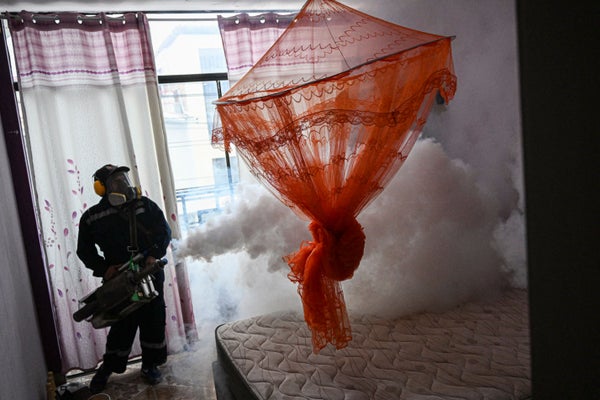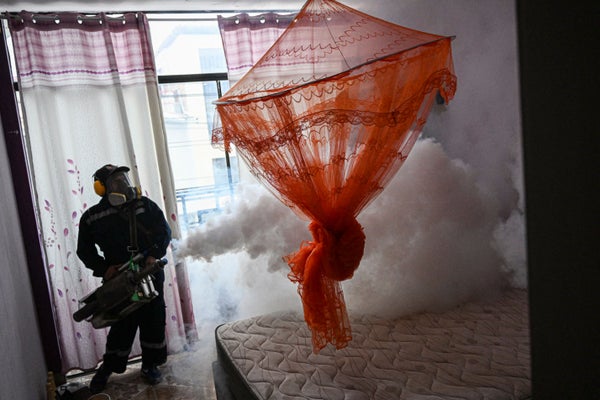A Dengue Fever Outbreak Is Setting Records in the Americas
At least 2.1 million cases of dengue fever have been reported in North and South America, and this year 1,800 people have died from the mosquito-borne disease

A worker fumigates a house against the Aedes aegypti mosquito to prevent the spread of dengue fever in a neighborhood in Piura, northern Peru.
Ernesto Benavides/AFP via Getty Images
CLIMATEWIRE | At least 2.1 million people in North and South America have been infected this year with dengue — a record-setting figure that scientists attribute in part to climate change.
The Pan American Health Organization says there have been about 2.1 million confirmed cases of the potentially fatal disease in the Americas since January. That’s already more than the record-setting mark of 2 million confirmed cases for all of 2023.
And this year’s figure could be much higher. As many as 5.1 million people may have been infected in North and South America, according to the Pan American Health Organization, the United Nations agency in charge of international health cooperation in the Americas.
On supporting science journalism
If you’re enjoying this article, consider supporting our award-winning journalism by subscribing. By purchasing a subscription you are helping to ensure the future of impactful stories about the discoveries and ideas shaping our world today.
The outbreak has pushed Puerto Rico, Peru and nine of Brazil’s 26 states to declare states of emergency. More than 1,800 people in the Americas have died this year from dengue.
“We already have a large number of cases this year, not only in Brazil but also Paraguay and Argentina and other countries — even Uruguay and areas where there has been no transmission of dengue for a century,” said Pan American Health Organization director Jarbas Barbosa in a March press briefing.
Dengue typically causes short-term symptoms such as rashes and joint pain but the disease can be life-threatening in severe cases.
Mosquito bites spread the disease to humans, and public health experts say that warmer winters that don’t kill enough mosquitoes are one cause contributing to dengue outbreaks.
A compounding factor this year has been El Niño, a natural, temporary, and occasional warming of part of the Pacific that generates higher precipitation in much of the Americas.
Those elements — higher temperatures and more rain — are foundational for dengue outbreaks because they create the perfect breeding grounds for mosquitoes.
Barbosa, in his March briefing, cited a “combination of climate change and El Niño” as key factors of this year’s outbreak.
The number of dengue cases in North and South America has exploded over the past several decades. Dengue cases in the Americas are roughly five times higher in the 2020s than in the late 1990s.
A March study published in the journal Nature found that mosquito reproduction speed is “strongly influenced” by temperature and rainfall because mosquitoes die off in colder weather and precipitation makes puddles for mosquitoes to lay eggs.
“Every heat wave is a push that builds up dengue transmission,” said Christovam Barcellos, co-author of the Nature paper and senior researcher at Brazil-based Fiocruz research foundation. “There are more heat wave incidents in central Brazil, and that is the zone most affected by dengue now.”
Barcellos said heat waves mean not only more mosquitoes: “People change their behavior when a heat wave comes, they go out on the streets more” which increases their exposure to disease-carrying insects.
“It’s a complementary phenomenon,” he said.
While the United States often sees thousands of dengue cases annually, only about 6 percent are locally acquired while most are picked up during travel, according to data from the Centers for Disease Control and Prevention.
But this year, health experts worry dengue could hit the lower 48 hard.
“If a series of heat waves also come to the U.S., it can augment transmission,” Barcellos said.
Kacey Ernst, chair of the Department of Epidemiology and Biostatistics at the University of Arizona, shares Barcellos’ concern.
“We have had sporadic cases of locally acquired dengue in Florida and Texas for years now, and Arizona saw its first locally acquired case in 2022, so the potential is there,” Ernst said.
“I don’t often use words like explosion of transmission,” Ernst said. “But it seems to be an accurate description of dengue transmission this year.”
Reprinted from E&E News with permission from POLITICO, LLC. Copyright 2024. E&E News provides essential news for energy and environment professionals.

